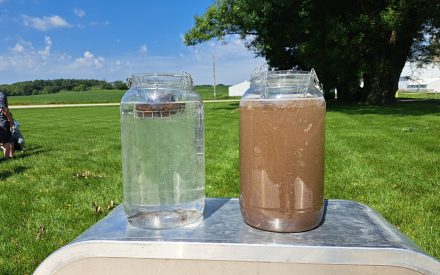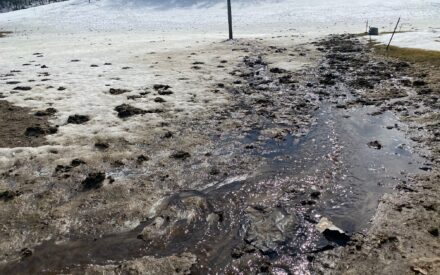This article was originally published in The Journal of Nutrient Management
The agriculture community has continuously adapted to fulfill the ever-growing desires and demands of society. This willingness to try out innovative practices which protect soil and water resources, while maintaining the productive capacity of the land, is essential to sustainable agricultural systems. A thorough understanding of the complex interactions between nutrients, water and plant growth is necessary to continue meeting the growing environmental pressures placed on the farming community.
According to the USDA Census of Agriculture, from 2007 to 2017, the amount of commercial phosphorus (P) fertilizer applied, and manure P generated, continued to increase in many states including Wisconsin; at the same time, farm acreage is shrinking. Over application of P contributes to both economic inefficiencies and environmental concerns, including harmful algal blooms and eutrophication of waterbodies. Although much effort has been put into conservation adoption and implementation to reduce the amount and impact of particulate P (moves with soil, Fig 1) lost from cropland, there continues to be issues with dissolved P (moves with water) entering the waterways of Wisconsin and beyond.
Impact of legacy P in croplands
Buildup of P in fields, whether due to overapplication of manure, unrealistic yield goals or legacy accumulation of nutrient from fertilizers or manure, is causing negative impacts on streams, rivers and lakes. Accumulation of P in the surface soil is common in soils which receive surface applied fertilizer and manure. This accumulation, as indicated by high surface soil test phosphorus results, can happen over years or even decades and P can continue to mobilize even after additional inputs cease. The mobility of legacy P in the dissolved form can act as a long-term source to surface waters. This unused P, which can leave fields dissolved in runoff, not only degrades water features but represents an economic loss to producers. Residual P can persist for many years with the only significant drawdown coming from crop removal at rates of 3 to 5 ppm per year, or worse, from runoff and soil loss. The impacts of this legacy P are visible even after aggressive steps are taken to reduce P inputs and losses.
Long-term changes in precipitation patterns and extreme weather events
Long-term monitoring by NOAA National Climatic Data Center has shown that Wisconsin, like other states in the Midwest, has seen a modest increase in both total precipitation and extreme precipitation events. Recently, Wisconsin has experienced some unusually wet years, and since 1990 there has been a trending increase in the number of days with 2-inch extreme precipitation events. With extreme precipitation events comes the potential for larger runoff events. The majority of annual nutrient and sediment runoff can occur during a few, or even just one, of these large events if proper precautions aren’t in place. Although Discovery Farms monitoring has seen extreme weather events occur, fields with appropriate conservation practices in place have been resilient to detrimental losses during these outlier events. Timing of these large precipitation events, and whether or not there is cover on the soil, will often determine the extent of losses, underscoring the importance of keeping up with practices to buffer the impact. One of the most evident impacts of large runoff events can be seen in fields which do not address concentrated flow areas (Fig 2, left). A well-established, grassed waterway is critical to preventing losses via concentrated flow (Fig 2, right). With the potential of an uncertain climatic future, preparation and the ability to adapt will result in resilient farming systems.
Continued refinement of conservation practices
Conservation practices which reduce erosion, increase infiltration and slow the movement of runoff are widely encouraged to address soil and phosphorus loss from agricultural landscapes. Grassed waterways, cover crops and conservation tillage, when used appropriately, have all been shown to improve the water quality impacts of agricultural practices. Why then, do we see continued impairment of waterways in Wisconsin due to excessive levels of phosphorus? While this can be frustrating at times, we need to continue to refine and develop management suggestions based on new and relevant information. There is an ever-growing need for generalizable knowledge on how management practices drive water quality outcomes at scales from the field to a whole watershed. There are many lessons to be learned from regional efforts at tackling water quality issues derived from nonpoint P sources.
Three case studies: Lake Erie, Chesapeake Bay and Wisconsin’s Phosphorus Rule
- Phosphorus load reductions into Lake Erie in the 1970s and 1980s were once touted as major environmental success stories. Yet in the mid 2010s, even after the implementation of conservation practices to target nonpoint source P loading, some of the largest and most widespread algal blooms ever witnessed in Lake Erie occurred. Some potential culprits of this re-eutrophication problem seem to be the increase in dissolved P loading, as well as an increase in precipitation which leads to more volume of water entering the tributaries leading to Lake Erie. Early efforts at tackling these issues targeted particulate P, which is just one potential pathway of P loading. This may have had some unintended consequences of increasing P stratification and buildup in the surface soil layers, leading to high levels of dissolved P during runoff events. Extreme precipitation events and long-term increases in the volume of water flowing in tributaries may also be pushing the dissolved P further into the Lake, causing a wider distribution of impacts.
- Chesapeake Bay is North America’s largest estuary and has over 12 million acres of farmland within the watershed that drains into the bay. Despite widespread efforts to reduce P loading, including a 2010 implementation of total maximum daily load (TMDL) effort, there continues to be water quality issues. As in the Lake Erie watersheds, Chesapeake Bay has seen some progress in the reduction of P loading from conservation practices aimed at reducing soil and particulate P loss. However, an acceleration of dissolved P has continued to cause issues in the bay. Again, a likely cause of this increase in dissolved P is the buildup of legacy P in the soil, which can potentially take decades to draw down. The impact of legacy P can oftentimes conceal the results from implemented conservation practices, as the release of this P can continue to cause issues long after conservation efforts are put in place. Long-term monitoring regularly sees continued high P loss from fields complying with nutrient management standards.
- The implementation of Wisconsin’s 2010 Phosphorus Rule developed TMDLs for surface waters in the state. While not directly regulating agricultural nonpoint P sources, the rule led to the development of important tools for best management practices and nutrient management planning. The Wisconsin P Index is a planning and assessment tool for managing runoff P losses from cropland. The P Index utilizes weather information, soil loss equations, and field-specific data about topography, slope and proximity to waterways, to estimate runoff P losses for a particular field. The P Index is integrated into Wisconsin’s nutrient management planning software SnapPlus. The P Index allows producers to evaluate how modifications to their fertilizer and/or manure management plans may reduce P losses and improve water quality impacts. The development of these tools has led to smaller, albeit significant, reductions in total P loading, yet the persistence of legacy P continues to push dissolved P out of fields, causing impaired water quality. Since the mid 1990s, consistent progress in point source reductions have been made through the use of Wisconsin Pollutant Discharge Elimination System permits, which has seen a 70% reduction in wastewater P from municipalities.
Stacking practices
Research suggests that no single practice holds the key to reducing environmental impacts of P loading. Recent efforts have highlighted the need for a multi-prong approach through bundling or layering management strategies. This includes the altering of timing and delivery of fertilizer and manure applications, use of cover crops, restoration of headwater wetlands, streambank fencing and vegetated riparian buffers to control drainage. There are limited short-term approaches to tackling the dissolved P issue associated with legacy P buildup, but some innovative strategies are being considered and tested. The use of so-called P sorbing materials, those that bind to P and reduce the solubility, have shown some promising results. Application of these amendments directly to the soil has risks and may only lead to short-term reductions, but the use of these materials in edge of field structures which filter runoff may be one innovative strategy for capturing dissolved P before it leaves the field.
Other opportunities may be found in social programs such as nutrient credit markets or water quality trading programs. These types of programs allow source polluters to offset their contributions by paying into a fund or by buying or trading credits in a marketplace from other producers or farmers who are making reductions in their pollutants. Voluntary opportunities such as environmental quality incentive programs and enrollment in conservation reserve programs are other indirect forms of reducing P source and loading. The establishment of producer-led watershed groups allows for collaboration among producers to implement and evaluate innovative management strategies through funding opportunities and research partnerships.
We don’t need to wait on policy
A major lesson learned is that widespread adoption of multiple practices aimed at addressing P loss, as well as continued monitoring of their impact, is necessary to continue to understand, advance and refine management recommendations. Everyone wants clean water, pollutant-free recreational opportunities and natural habitats for aquatic creatures. Addressing the environmental impacts of agriculture need not wait or rely on regulations. Through collaboration and innovation, proactive efforts from all stakeholders will further the goals of improving water quality.

 Cover crops for improved surface water quality: Benefits and limitations
Cover crops for improved surface water quality: Benefits and limitations Spring impacts of climate change on Wisconsin agriculture
Spring impacts of climate change on Wisconsin agriculture ▶ Watch: Soil health practices impact on phosphorus pools and availability
▶ Watch: Soil health practices impact on phosphorus pools and availability Save money and get cleaner water by correctly utilizing manure
Save money and get cleaner water by correctly utilizing manure


